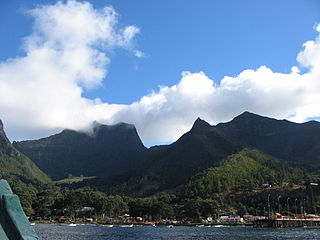
The Juan Fernández Islands are a sparsely inhabited island group in the South Pacific Ocean reliant on tourism and fishing. Situated 670 km off the coast of Chile, they are composed of three main volcanic islands: Robinson Crusoe, Alejandro Selkirk and Santa Clara. The group is considered part of Insular Chile.
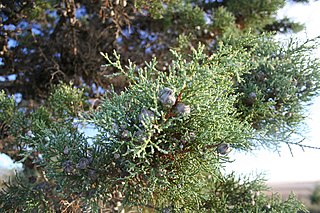
Cypress is a common name for various coniferous trees or shrubs of northern temperate regions that belong to the family Cupressaceae. The word cypress is derived from Old French cipres, which was imported from Latin cypressus, the latinisation of the Greek κυπάρισσος (kyparissos).

Myrceugenia is a genus of evergreen woody flowering trees and shrubs belonging to the myrtle family, Myrtaceae, first described as a genus in 1855. The genus is native to South America from central Brazil to southern Chile. It is closely related to the genus Luma; some botanists include Myrceugenia in that genus.

Nothofagus pumilio, the lenga beech, is a deciduous tree or shrub in the Nothofagaceae family that is native to the southern Andes range, in the temperate forests of Chile and Argentina to Tierra del Fuego, from 35° to 56° South latitude. This tree is in the same genus as the coihue. It regenerates easily after fires. The wood is of good quality, moderate durability, and is easy to work with. It is used in furniture, shingles and construction and sometimes as a substitute for American black cherry in the manufacturing of cabinets.
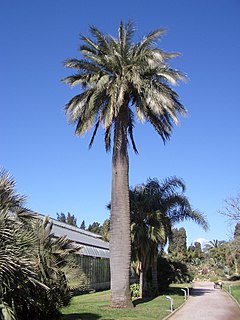
Jubaea is a genus of palms with one species, Jubaea chilensis or Jubaea spectabilis, commonly known in English as the "Chilean wine palm" or "Chile cocopalm", and "coquito" in Spanish. It is native to southwestern South America and is endemic to a small area of central Chile between 32°S and 35°S in southern Coquimbo, Valparaíso, Santiago, O'Higgins, and northern Maule regions.

Hassan Ehsan Masood is a science writer, journalist and broadcaster. Since 2009 he has been the editor of Research Professional News and has been teaching international science policy at Imperial College London. since 2008.

La Campana National Park is located in the Cordillera de la Costa, Quillota Province, in the Valparaíso Region of Chile. La Campana National Park and the Vizcachas Mountains lie northwest of Santiago. This national park covers approximately 80 square kilometres (31 sq mi) and is home to one of the last palm forests of Jubaea chilensis, which prehistorically had a much wider distribution than at present. Another attraction is the Cerro La Campana, which lends its name to the park. In 1834 Charles Darwin climbed this mountain, during the second voyage of HMS Beagle.

Archipiélago de Juan Fernández National Park is a national park located in the Pacific Ocean 665 kilometres west of Chile's mainland port of San Antonio, in the Juan Fernández Archipelago. The park covers 96 square kilometres and comprises the Santa Clara, Alejandro Selkirk and the most part of the Robinson Crusoe Island islands.

The Chilean mockingbird locally known as tenca is a species of bird in the family Mimidae. It primarily inhabits Chile's northern half, though there are sightings in Argentina.
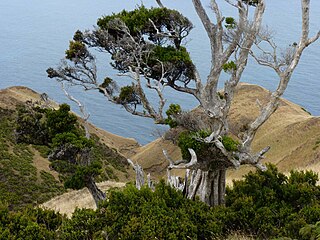
Myrceugenia schulzei is a species of plant in the family Myrtaceae. It is endemic to Alejandro Selkirk Island, of the Juan Fernández Islands archipelago in the Pacific Ocean, territory of the Republic of Chile. It is threatened by habitat loss.
Adiantum gertrudis is a threatened species of ferns in the Vittarioideae subfamily of the Pteridaceae that occurs in central South America. One locus of occurrence of A. gertrudis is within central Chile at the La Campana National Park. A morphological trait unique to A. gertrudis is the hairs covering its fronds.
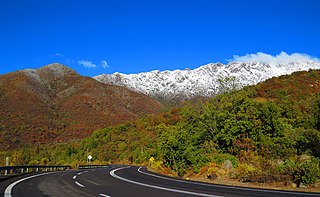
Cuesta La Dormida is a mountain in central Chile. Some of the forested mountain area of Cuesta La Dormida has been added to the La Campana National Park in order to achieve protection for the Chilean Wine Palm and other endangered species. Forests on Cuesta La Dormida provide habitat for a number of bird and mammal species in addition to the flora mosaic itself.

The Salto Grande is a waterfall on the Paine River, after the Nordenskjöld Lake, within the Torres del Paine National Park in Chile. In the vicinity of Salto Grande are a variety of natural vegetation forms as well as certain wildlife species, including the wild guanaco.
Adesmia resinosa is a species of flowering plant in the legume family, Fabaceae. It belongs to the subfamily Faboideae. The species is found in portions of South America, with an example location being La Campana National Park in central Chile as an understory associate of the Chilean wine palm.
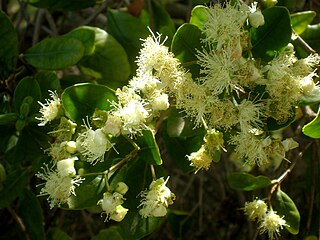
Myrceugenia exsucca is an evergreen woody flowering plant species of the Myrtle family, Myrtaceae. The species is native to South America as far south as Chile. An example occurrence is in central Chile within the La Campana National Park. A common name for this tree is petra.

Echinopsis chiloensis is a species of cactus native to South America; genus members are known as hedgehog cacti, sea-urchin cactus or Easter lily cactus.
Science and Islam (2009) is a three-part BBC documentary about the history of science in medieval Islamic civilization presented by Jim Al-Khalili. The series is accompanied by the book Science and Islam: A History written by Ehsan Masood.

Showak , is a town on the Atbarah River in eastern Gedarif State, Sudan, at an altitude of 516 meters above sea level. It lies at a distance of 381 kilometres (237 mi) to the northeast of Khartoum. Showak is a major transport hub between Gedaref, the state capital and Kassala city.
Myrceugenia rufa is a species of shrub in the genus Myrceugenia of the family Myrtaceae. It is endemic to Chile, where it grows in forest remnants near the coast and is considered "endangered".
Myrceugenia colchaguensis is a species of small evergreen tree in the genus Myrceugenia of the family Myrtaceae. It is endemic to Chile where it is found in the coastal mountain range at altitudes below 400 m (1,312 ft). Common names by which this tree is known include colchaguillo, arrayan de colchagua and lumilla.













